We purchased our Jeep with about 105,000 miles clocked, and I soon found out that quite a bit of routine maintenance had been neglected by the previous owner(s). After a couple months I started hearing a squeaking noise from underneath the vehicle which matched tire speed at lower RPMs. After a bit of checking around, I discovered that this is a fairly common problem in newer Jeeps, and it is commonly referred to as “angry sparrows.” The problem is apparently due to inadequate sealing/lubrication in the stock constant velocity (CV) assembly of the front drive shaft. Online Jeep message boards seem to have dozens of “my jeep is squeaking” questions, all eventually diagnosed as the same CV issue.
It has been suggested that it is possible to spray lubricating oil into the CV assembly, under the dust cover, to temporarily eliminate the squeaking noise. If this method is effective in eliminating the squeaking noise, it is likely that the CV assembly is failing. While the oil is a helpful diagnostic tool, and it may temporarily eliminate the squeaking noise, it should be noted that this is not a solution to the problem, and some maintenance should be performed in the near future.
The most common online resource addressing the “angry sparrows” problem is Stu Olson’s Jeep Site, where a nice pictorial breakdown of the front drive shaft is available. The guide is easy to follow and covers removal, disassembly and assembly of the front shaft. I have made this page as a supplement, in order to provide a bit more specific information related to the CV assembly overhaul.
Materials
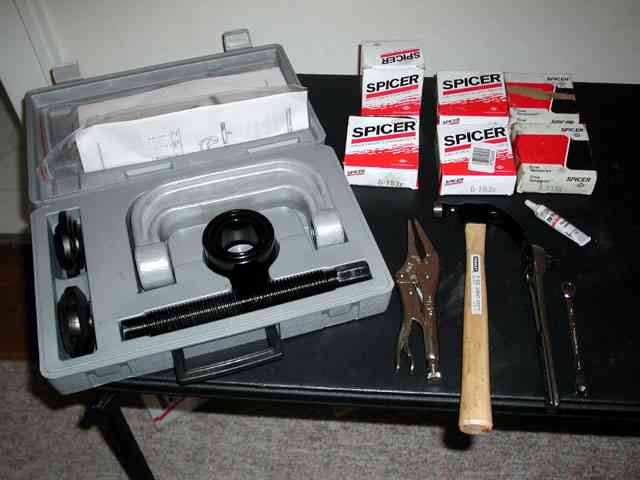
Pictured above are most of the items required for a fairly complete overhaul of the front and rear drive shafts. On the left is a Harbor Freight u-joint tool. I long ago learned that having the right tool for the job is crucial for minimizing a painful automotive task. Not pictured is the 24″ breaker bar with the socket I used to turn the threaded rod. The u-joints had been in place for about seven years, and I do not think I could have coaxed them out without this tool. Stu uses a small bench-top vise to help remove some of the u-joint caps, and I used a large vise-grips (not pictured) and the hammer. The needle-nose vise grips were used for removal and installation of the retaining rings.
The ratchet wrench, 8mm socket and 8mm ratcheting wrench were used for the drive shaft removal and installation. When I pulled the front and rear shafts I noticed that most of the bolts had loc-tite, so I made sure to re-apply some to the bolt threads when I re-installed the shafts.
The six boxes contain five greasable u-joints and the CV centering ball kit. The front shaft requires three u-joints and the rear requires two. The stock u-joints are not serviceable without complete disassembly, as shown in Stu’s writeup, so I decided to replace the stock units with Spicer greasable 1310 u-joints. Spicer parts are highly recommended by many, while AutoZone and Precision brand parts were frequently listed as items to avoid. I have no personal experience with these other brands. Part numbers are listed below.
| Brand | Part Name | Part Number | Approximate Price |
| Spicer | 1310 U-joint | 5-153x | $12.95 each at NAPA |
| Spicer | Ball Centering Kit | 211355x | $64.95 at NAPA |
| *Rockford | Ball Centering Kit | R2-21-1355 | $31 online |
| **Rockford | CV Repair Kit | 404-0 | $12.45 online |
*alternate to Spicer 211355x, **possible alternative to buying the entire ball centering unit
CV Disassembly/Assembly
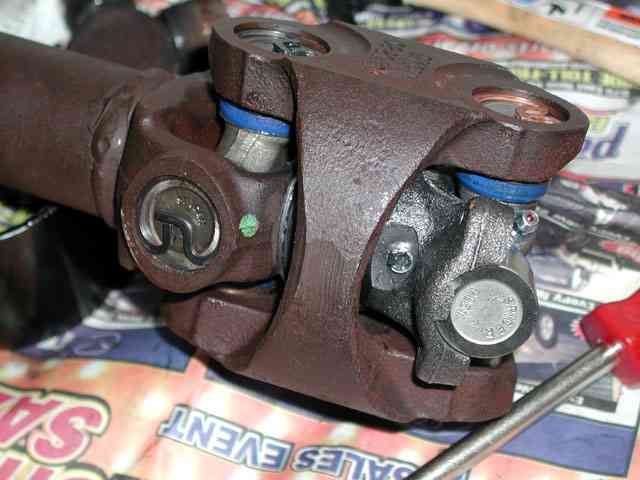
Pictured above is the actual CV section of the front drive shaft. This type of CV assembly is known as a double cardan. As pictured, the right side bolts up to the front of the transfer case, the left would continue down to the front differential. This picture was taken after re-assembly. After removing the outermost u-joint, the ball centering unit may be freely removed (it will likely fall out). Note that there are needle bearings and a spring inside of the opening on the shaft side. The stock and replacement ball centering units are pictured below for comparison.
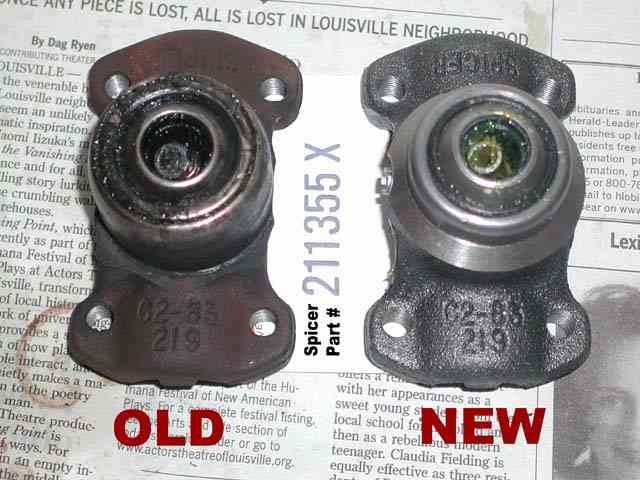
The stamped numbers on the ball centering assemblies matched, but you may note significant design differences, including grease fittings. A close up of the fittings is shown below.
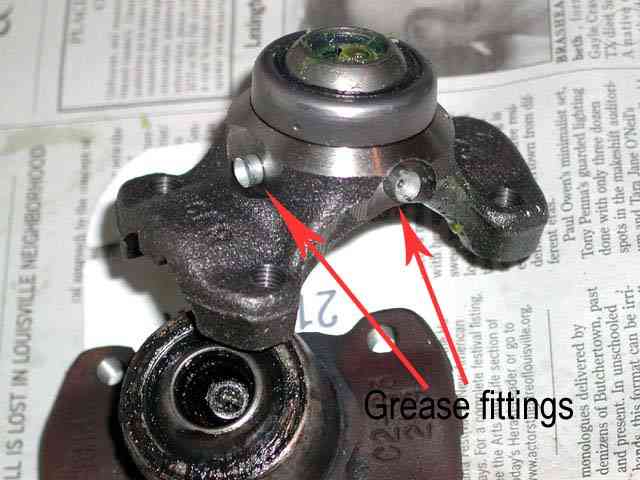
A standard grease gun will not work with these fittings, so I asked for the appropriate fitting at NAPA when I picked up my parts. They sold me a ‘u-joint needle adapter” (NAPA part #715-1213, pictured below), which clips on to the end of a standard grease gun.
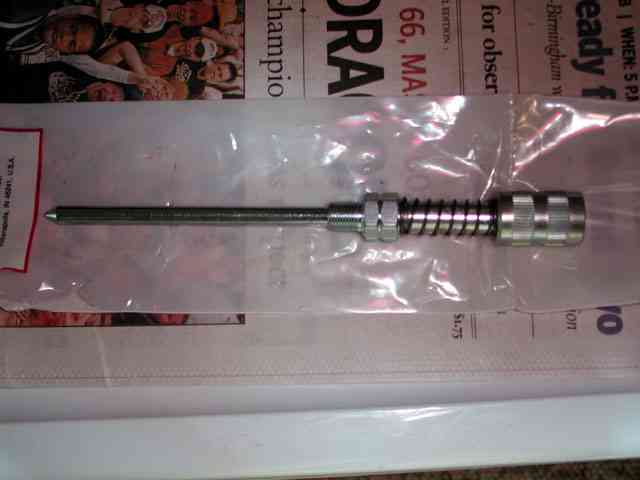
With the outermost u-joint and the ball centering assembly removed, the outer yoke is still attached by the inner u-joint as seen in the picture below. I recommend marking the position of the outer yoke in relation to the shaft to eliminate possible sources of vibration after re-assembly.
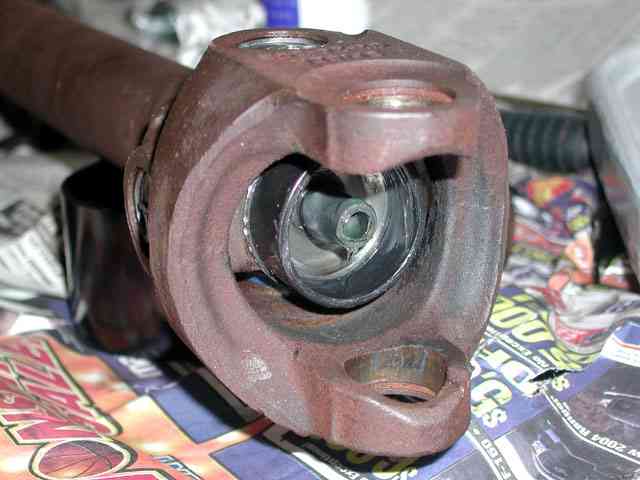
When I removed the inner u-joint, the yoke pushed against the dust cover (black cylinder), knocking it off of the main shaft. I cleaned the cover and it was easily fit back into place by tapping along it’s edge with a screwdriver and hammer. The picture below provides a breakdown of these pieces.

Of note in the above picture is the location of the u-joint grease fitting. The u-joint package included a slip of paper stating that u-joint grease fittings should point away from the yoke when installed. I assume this is to prevent the shaft from binding breaking the fitting. In the completed picture at the top of the page, note that the fitting on the outer u-joint also points away from the yoke.
The assembly steps were exactly the reverse of my disassembly, with no exceptional difficulties in the process. I applied a thin layer of grease on the metal surfaces of the ball centering assembly and the metal surfaces inside the dust cover pictured above. My only problem occurred when installing the outer u-joint, due to the pressure of the spring in the ball centering unit pushing the u-joint out when I was trying to fit it into the outer yoke. It may be easier to install the outer u-joint in the outer yoke first, then slide the yoke, including ball centering assembly, over the inner u-joint.
Make sure to grease the u-joints before you take a test drive. I greased them while the drive shaft was still out of the vehicle, because the there is little/no access to the CV fittings with the shaft installed.
Final Note:
The overall time I spent on this project, including replacing the two u-joints in the rear shaft, was about four to six hours. Most of my trouble came from stubborn u-joints which were solidly fused in place. If I had to do the project again it would probably take about two hours. Total cost of parts was around $130.00, and an additional $70.00 or so for various tools (including the u-joint tool). The u-joint tool would have been very useful for the pin in the steering stabilizer, and the sockets for the control arms on the anti-sway bar. If “angry sparrows” have been a problem for you lately, hopefully this guide has been a useful supplement to Stu’s excellent front shaft teardown.
If you have any questions, you are welcome to email me.
Happy Wheeling,
Zach Matson
